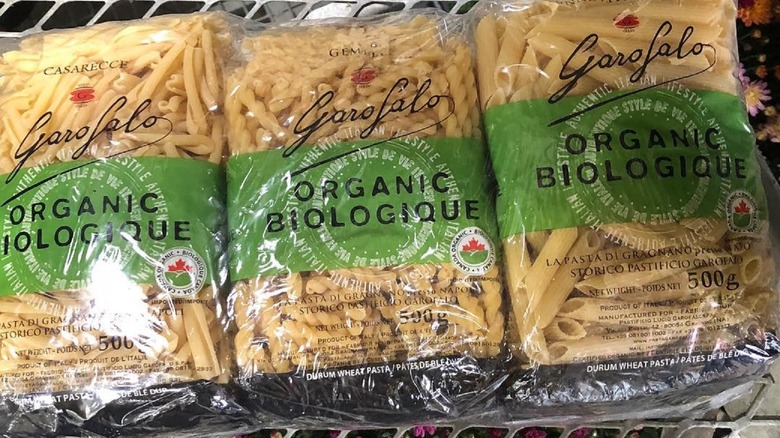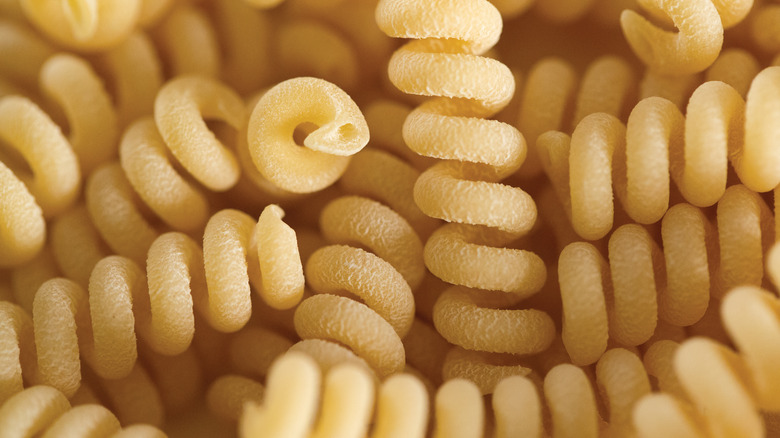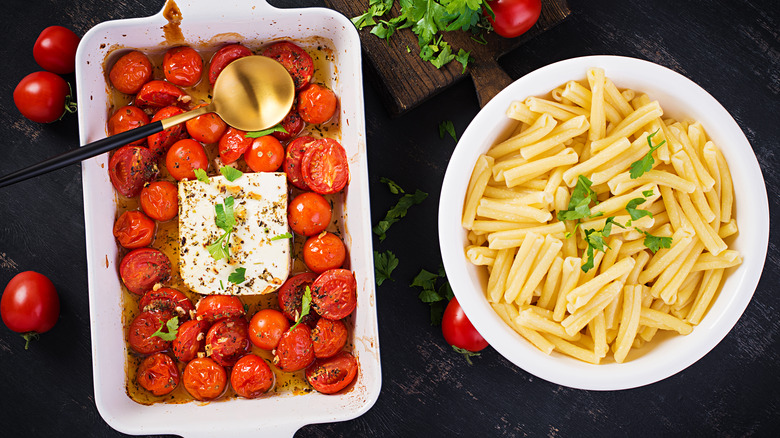The Imported Italian Pasta That You Need To Look For At Costco
Pasta is among the ultimate pantry staples, and there is no better place to stock up on pasta than Costco. But don't stop at your typical blue-box supermarket staples; the Garofalo variety packs are beckoning you. The variety pack, with 6 pounds of pasta, gives you two, 1-pound packs each of casarecce, penne ziti rigate, and gemelli. Gemelli is two strands of pasta twisted together, while casarecce is a narrow, short sheet of pasta rolled lengthwise into a scroll-type shape. And if the combination of terms in "penne ziti rigate" is throwing you for a loop, you're not wrong to think those are typically different shapes: Ziti typically refers to a square-ended, non-ribbed pasta shape, and Garofalo's is indeed angle-cut and ribbed, or "rigate."
The organic pasta is imported from Gragnano, Italy, a small hill town located outside Naples on the Amalfi coast. Gragnano is actually the birthplace of dried pasta — the area has been producing it commercially for over 1,000 years. The E.U. recognizes pasta made here under a Protected Geographical Indication, which designates adherence to a culturally important and geographically unique production of a product. Garofalo has only been making pasta for 234 years, but it is very serious about it (and many of its shapes, like the penne ziti regati in the variety pack, do carry the PGI certification).
What makes Garofalo so good?
Like Irish water makes Guinness and New York City water makes bagels, Gragnano water makes pasta. The low mineral content of the water from the area prevents major structural changes to the semolina, preserving the quality of the wheat. In order to be stamped with the PGI certification, the region's pasta must be made with local water and high protein durum wheat semolina, dried at a low temp, and bronze extruded. If you've never had a bronze cut pasta, you're missing out. The additional texture from extruding through a bronze machine helps sauce stick to the pasta (or you could always hit your pasta with some sandpaper).
Garofalo takes its durum wheat semolina grain seriously. Every bag is traceable back to where the grain was grown. Semolina is one of the staple crops of hot and dry areas of Italy, like Sardinia (known for its amazing pasta shapes), and so it also grows well in Australia and — believe it or not — Arizona. The wheat is all transported back to Gragnano for production.
Garofalo uses high-quality, high-gluten content semolina for springy noodles that hold their shape well when cooked. And it's serious about its pasta science, too, tracking moisture levels in dough, humidity in drying, gluten percentages, and more. You can read all about your own batch of pasta by searching the expiration date on its website and downloading a multiple-page PDF.
How to sauce your Costco Garofalo
Different shapes of pasta call for different sauces. Long, thin pasta like spaghetti pairs well with light, delicate sauces — nothing at all chunky. For alternatives to tomato sauce, pair your spaghetti with a buttery herb sauce or a simple aglio e olio sauce.
Ribbed, tubular pasta like Garofalo's penne ziti rigate is where you want to use heavy, chunky sauces like bolognese, or a loaded vegetable, sausage, ragu, or eggplant sauce. Not only do the ridges help grip the sauce, but the ground meat, chunks of sausage, or chopped vegetables in these sauces get carried inside the tubes.
For spiral pasta like gemelli and casarecce, heavier, smooth sauces work well. Carbonara, pesto, alfredo, the viral tomato feta baked sauce, or a dense marinara would work great. The sauce gets carried in the curves of the gemelli, and caught in the scrolls of the casarecce.


